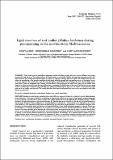Por favor, use este identificador para citar o enlazar a este item:
http://hdl.handle.net/10261/2358COMPARTIR / EXPORTAR:
 SHARE SHARE
 CORE
BASE CORE
BASE
|
|
| Visualizar otros formatos: MARC | Dublin Core | RDF | ORE | MODS | METS | DIDL | DATACITE | |

| Título: | Lipid reserves of red mullet (Mullus barbatus) during pre-spawning in the northwestern Mediterranean |
Otros títulos: | Reservas lipídicas del salmonete de fango (Mullus barbatus) durante la prepuesta en el Mediterráneo noroccidental | Autor: | Lloret, Josep CSIC ORCID ; Demestre, Montserrat CSIC ORCID ; Sánchez-Pardo, Josep CSIC | Palabras clave: | Ecological physiology Polychaetes Fishing River runoff Maerl beds Ecofisiología Poliquetos Pesquerías Descargas fluviales Fondos de maerl |
Fecha de publicación: | 30-jun-2007 | Editor: | Consejo Superior de Investigaciones Científicas (España) | Citación: | Scientia Marina 71(2): 269-277 (2007) | Resumen: | [EN] Lipid reserves are a particularly important attribute of fishes because they have a large influence on growth, reproduction and survival. This study analyses the lipid content of red mullet (Mullus barbatus) pre-spawners in three different areas of the northwestern Mediterranean in relation to trawling activities and river runoff. The muscle lipid was considered as an indicator of the somatic condition of individuals whilst the gonad lipid was used as a proxy of the energy invested in reproduction. The results show that fish with the highest muscle lipid levels inhabited the area where fishing impact was lowest. Since the abundance and biomass of polychaetes, which represent the main food source for red mullet, were found to be lower in trawled zones than in unfished ones, we suggest that differences in the muscle lipid levels between areas might be attributed to variation in prey abundance in relation to fishing impact. However, no impact of river runoff on lipid reserves of red mullet was observed. The results also show that muscle and gonad lipid reserves are not related to each other during pre-spawning [ES] Las reservas lipídicas constituyen un importante atributo de los peces porque juegan un papel destacado en su crecimiento, reproducción y supervivencia. Este estudio analiza las reservas lipídicas del salmonete de fango (Mullus barbatus) durante la prepuesta en tres áreas diferentes del Mediterráneo noroccidental en relación a la actividad pesquera y las descargas fluviales. Se ha considerado el contenido lipídico en el músculo y en la gónada como indicadores de la condición somática y de la energía invertida en la reproducción de los individuos respectivamente. Los resultados muestran cómo los peces con una cantidad mayor de lípidos en el músculo habitan el área donde el impacto pesquero es menor. Puesto que la abundancia y la biomasa de poliquetos, que constituyen la principal fuente de alimento del salmonete de fango, son inferiores en las zonas afectadas por el arrastre que en las zonas donde no se practica este tipo de pesca, se sugiere que las diferencias en la cantidad de lípidos en el músculo entre las distintas áreas podrían atribuirse a las diferencias en la abundancia de presas, lo cual podría guardar relación con la actividad pesquera. Sin embargo, no se observa impacto alguno de las descargas fluviales sobre las reservas de lípidos del salmonete de fango. Los resultados también muestran cómo los contenidos lipídicos en el músculo y en la gónada de los ejemplares no están relacionados entre sí durante la prepuesta de la especie |
Versión del editor: | https://doi.org/10.3989/scimar.2007.71n2269 | URI: | http://hdl.handle.net/10261/2358 | DOI: | 10.3989/scimar.2007.71n2269 | ISSN: | 0214-8358 | E-ISSN: | 1886-8134 |
| Aparece en las colecciones: | (ICM) Artículos |
Ficheros en este ítem:
| Fichero | Descripción | Tamaño | Formato | |
|---|---|---|---|---|
| Lloret_et_al_2007.pdf | 235,16 kB | Adobe PDF |  Visualizar/Abrir |
CORE Recommender
SCOPUSTM
Citations
37
checked on 12-abr-2024
WEB OF SCIENCETM
Citations
31
checked on 15-feb-2024
Page view(s)
376
checked on 19-abr-2024
Download(s)
236
checked on 19-abr-2024
Google ScholarTM
Check
Altmetric
Altmetric
NOTA: Los ítems de Digital.CSIC están protegidos por copyright, con todos los derechos reservados, a menos que se indique lo contrario.
